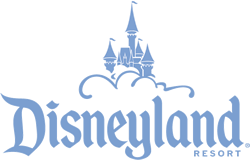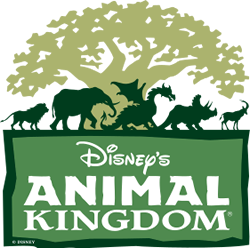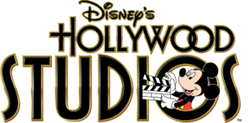-Stage 4.7-
Dinos of Disney
The Disney parks have fantastic dinosaurs, as well as other geological and paleontological features, throughout their many properties. Here, I go into these various dinosaurs, and other geological features, as well as the attractions that they can be found in, from the parks that I have visited.
Disneyland Railroad (AKA Primeval World)
Galaxy's Edge (see Hollywood Adventure)
DinoLand U.S.A.
Chester and Hester's Dino-Rama!
Slinky Dog Dash - Rex the T. rex
Dinosaur Gertie's Ice Cream of Extinction
None at this time
Big Thunder Mountain Railroad (See Disneyland)
Maleficent Dragon Parade Float
This is from a trip I took back in December of 2017, during a spontaneous Christmastime trip. Big Thunder Mountain is one of the main roller coasters of Disneyland that has been replicated 3 other times in parks around the world (two of which also have the dinosaur). The theme of the ride is based on Monument Valley, a Navajo Tribal Park that straddles the border between Arizona and Utah. Here is the setup for the ride from Disney:
"Legend has it that after gold was discovered in the 1850s, eerie incidents took place in the mine. Trains would take off and race through tunnels… by themselves.
As you enter the cursed cavern, your train speeds up along the rickety track. Shoot under a booming waterfall and dodge a falling boulder from an unexpected landslide as you swoop around sharp turns and drop into desolate canyons.
On this rip-roaring adventure, you may learn that some legends turn out to be true..."
As you whip around the track, you eventually end up face-to-face with a dinosaur skeleton.

My view of the dinosaur skeleton while riding the ride at night.
The skeleton is interesting because from my view at night, it is really hard to determine what kind of dinosaur it is. Getting some better shots from Disney we can definitely get a clearer view of the dinosaur.

Here is a full shot of the skeleton from the official Disneyland ride website.
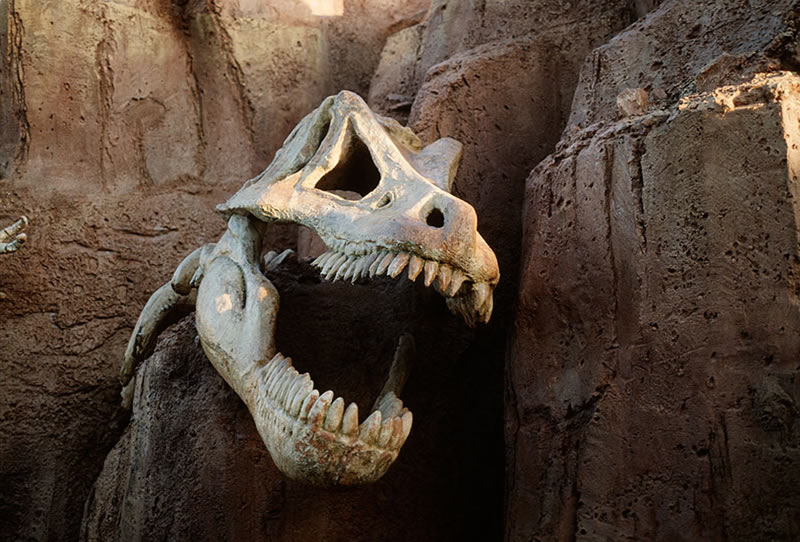
The Walt Disney World version of the skull, apparently taken in 1981.
And looking closely at the skull you can tell that it is probably meant to resemble a Tyrannosaurus rex skull, but it's ... off. Let's compare it to arguable the most famous T. rex, the Field Museum's SUE.
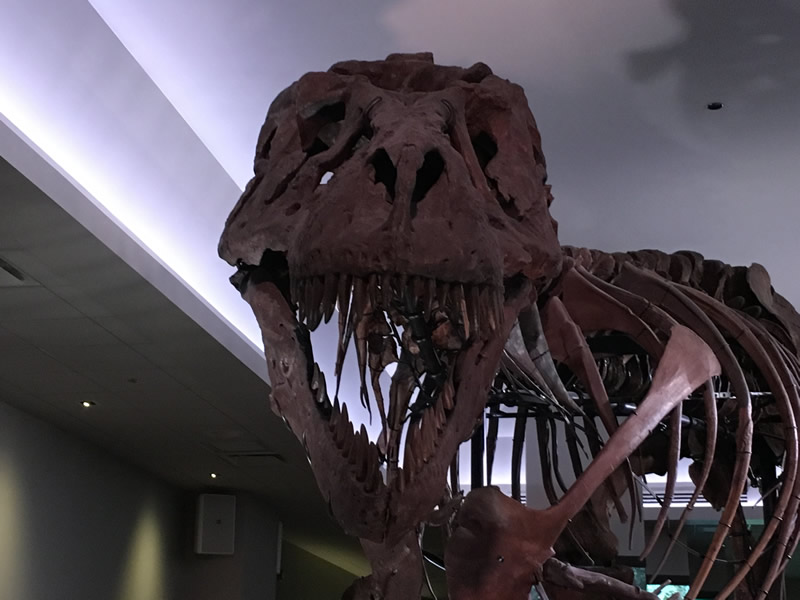
SUE the T. rex from the Field Museum in Chicago

SUE the T. rex from the Field Museum in Chicago
And I think, after comparing the Big Thunder Mountain T. rex to SUE, the biggest problem with the skull is the teeth. It's as if the designers tried to cram as many teeth as they could into the mouth, and all of the teeth are the same size, whereas in the real skull the teeth are constantly coming to replace lost or worn teeth, so the size and spacing of the teeth differ widely within the actual T. rex's mouth. The overall dimensions of the fenestra (holes) are also smaller in the Disney skull than in the real animal, however I could attribute that to making the skull more durable with more surface area.
What I really wondered was where did the idea of this dinosaur come from. Was it meant to be a T. rex or something else. I find it really telling that the D23 post called "The Ultimate Dino-Tour of Disney Parks all Over the World" that goes over many of the dinosaurs in the Disney Parks just calls this "the bones of a dinosaur". No attempt was made at even naming the species, whereas they name the species of many of the other dinosaurs in the post.
Tony Baxter himself, designer of Big Thunder Mountain, stated that the dinosaur bones were meant as a tribute to the previous incarnation of the ride. Parts of the ride and theme were actually taken from the previous renditions of the ride called Rainbow Caverns Mine Train, which was then converted into the Mine Train through Nature's Wonderland. However, I haven't been able to find any pictures of any dinosaurs from those versions. The closest thing I could find, was that the second version mentioned dinosaurs during the ride, but that was about it.
So although many Disney fans seem to have unanimously determined that this is a T. rex skeleton, Disney itself has shied away from denoting it as anything other than a "dinosaur".
Disneyland Railroad (AKA Primeval World)
Normally, when we rode on the Disneyland Railroad, we would take the Main Street, U.S.A. Station around to the various parts of the park we wanted to visit. The last stop we would get off would be at the Tomorrowland Station, because afterwards it just circles back to the beginning. So, we never felt the urge to ride from Tomorrowland to the Main Street, U.S.A. Station, however, this is where the dinosaur fun begins.
.jpeg)
Before even hopping on the train, they have these rotating billboards that have "advertisements" for each part of the park that the train stops at. They even have one for the dinosaur exhibit stating "Primeval World. Enter the World of the Dinosaur. Temporal Zone 200,000,000 BC".
.jpeg)
The ride to the Primeval World begins with a trip along the Grand Canyon, specifically this Grand Canyon Diorama that was added to the railroad in 1958. The diorama is 306 feet in length and provides an exquisite view of the south rim of the Grand Canyon, which also includes some animals and trees along the way. After this you are then transported back into the Primeval World.
"That was the Grand Canyon as we know it today, but it wasn't always that way. Quiet now, as we travel back in time, back to the fantastic Primeval World, land of the dinosaurs!"
The Primeval World was a series of Audio-Animatronics dinosaurs originally created for the Ford Magic Skyway at the 1964 New York World's Fair. The original ride was created as a time travel experience where people sat in Ford cars during the ride with the scenes narrated by Walt Disney himself. The scenes from the ride were taken from the Rite of Spring segment of 1940's Fantasia, which in and of itself had some paleontologically problematic scenes, as we will see below. Not all of that Magic Skyway experience had been transferred here, just the dinosaurs.
.jpeg)
The first animal we encounter is an Edaphosaurus, which unfortunately I did not get a good picture of. Edaphosaurus is a relative of the more common Dimetrodon, a synapsid from the Late Carboniferous and Early Permian time periods. Generally, this means that Edaphosaurus was not a dinosaur but closer related to mammals, and actually was completely extinct by the time any of the dinosaurs started to appear.
.jpeg)
The next series of animals we encounter is the group of Brontosaurus seen above. The posture of the body in these animatronics gives a sort of "loch ness" vibe to them with the curve of the neck, whereas in the real would stick out more and the tail would also be raised above the ground. The comment that their postures are incorrect is actually a general comment for all of the animals in this exhibit, as that it has been scientifically determined since these animals were created that they were able to keep their tails elevated off of the ground with their spines more or less straight. Side note: the three baby Brontosaurus were called Huey, Dewey, and Louie by Walt.
.jpeg)
The next animals on our prehistoric journey is the Pteranodon, pictured here with a group towards the back. Generally, it has been noted that their posture is not the best, especially if they are resting or walking. It has been shown that they do use all four limbs when walking, causing their wings to fold back behind them, instead of open like this.
.jpeg)
A up-close view of one of the Pteranodons, unfortunately the window lines tended to get in the middle of my pictures.
.jpeg)
The next up is a family of Triceratops watching their babies hatch. From what I can tell, scientifically, these are pretty good and the detail on them is quite amazing given when they were created.
.jpeg)
The next scene is a group of Struthiomimuses. The only dated aspect of these is that they likely had feathers. There are also several skeletons lying around on the ground. These skeletons are a bit difficult to view here but they include a Megalosaurus (seen here on the left) and a Plateosaurus, which is directly behind the Megalosaurus up on the hill a little bit.
.jpeg)
And we make it to the final shot of the train ride, which is also one of the climax shots of the Right of Spring. The most obvious complaint that we have here is that Stegosaurus and Tyrannosaurus rex lived in completely different time periods, so the possibility of this battle ever happening outside of a Jurassic Park cloning experiment is absurd. Stegosaurus lived during the Jurassic period (~150 million years ago), while the Tyrannosaurus live during the Late Cretaceous (~70 million years ago). That is more of a time difference than is between the T. rex and us now.
.jpeg)
Looking at the reconstructions of the dinosaurs, the T. rex could be considered to the the typical 1940's(ish) T. rex, complete with upright stance and a rather small head for the rest of its body. The shape of the skull is also completely off. They did fix the skull shape somewhat for the other T. rex in Disneyland on Big Thunder Mountain, although that one isn't perfect either. It also have 3 fingers, which most grade school kids would be able to tell you that the T. rex only has 2 fingers, while other large predators like Allosaurus typically have 3. The end of the Stegosaurus tail is also colored as if it is a spike as well, instead of just the end of its tail. This seems to indicate the creators of it gave it 5 spikes instead of the actual 4 it should have.
The Millennium Tree is the cross section of a real redwood trunk that records over 1,000 years from the time it sprouted up through the 1930's. Paleontologists actually use tree rings and cross sections like this to do many things, not the least of which is discovering what our planet's climate was like over the past several thousand years. This is a study known as dendrochronology, where each ring on the tree represents one year of growth and that individual ring can tell us a lot about the climate and atmosphere at the time the tree formed. By comparing the thickness of the individual rings, scientists can tell us if the climate was warmer or cooler, or wetter vs dryer, that year compared to other years.
.jpeg)
The rings also preserve the prehistoric atmosphere in the form of isotope data. Isotopes are different weights of various elements based on the number of neutrons that each element has. Many isotopes are unstable (radioactive), but there are many isotopes that are stable. Carbon for instance has two stable isotopes, Carbon-12 and Carbon-13. It also has several unstable isotopes, with the most prevalent one being Carbon-14. But the percentage of the different carbon isotopes is affected by the climate and this difference is then preserved in the tree as the tree builds up the woody plant matter in its trunk as it grows.
By comparing all that data for this tree to countless other trees across the globe, scientists are able to get a global view of the climate over time. They can also use the comparative thicknesses and isotope data in modern trees to line up older, already fallen trees, that they don't know when they were chopped down, such as in log cabins and other human settlements. The relative thicknesses of the rings forms a type of fingerprint that can be lined up with these older trees forming a continuous history of our climate that goes back much further in time than any tree living today is capable of. By understanding the isotopes and climate today, we can use that information to infer what the climate was in the past by the data preserved in these tree rings.
.jpeg)
The text for the tree:
The Millennium Tree
"Redwoods are ... ambassadors from another time"
- John Steinbeck
Travels with Charley (c. John Steinbeck 1962)
Every tree has a tale to tell, and the tree's rings tell us its story. A California redwood grows by adding a new layer, or ring, of wood to its surface each year, so counting the rings reveals the tree's age. Written in the rings of this fallen tree are over 1,000 years of California history from 818 A.D., then it sprouted, to 1937 when it fell.
Below are some close up shots of the tree to better read what each of the labels said from the main image.
.jpeg)
.jpeg)
.jpeg)
.jpeg)
.jpeg)
One part of Disney's California Adventure that really screams "Geological Wonder" is the Radiator Springs Racers ride towards the back of the park in what is known as "Cars Land". The backdrop of the ride is an awesome looking faux rock built panorama, evoking a southern Utah feel to it. They even provide a National Park Service type brochure explaining all of the features.
The region is even known as "Ornament Valley", an obvious play of the real life Monument Valley, a Navajo Tribal Park that straddles the border between Utah and Arizona.

Here is a photo of Monument Valley. This also happens to be the "Forest Gump Hill", where we, of course, stopped for photo ops.
The "National Park Brochure" for Ornament Valley is pictured above and below. (I tried to do a panorama shot on it but it is really hard to do that on an iPhone for a static picture so I also took an overall picture.) They have fantastic references to actual geologic features like "Pipe's Peak", "Mount Ever Rust", "Lincoln Continental Divide", and "Mount Hood".
As you can tell, several of the name are reminiscent of other features across the country (i.e. Mount Hood, referencing the volcano Mount Hood in Oregon, and Pipe's Peak referencing Pike's Peak another mountain in Colorado). The actual "geological" formations that they are showing are also reminiscent of features in Utah.

The Lost Wheel Arch on the right of the brochure, and under which the path goes in the photo above, bears a striking resemblance to the Window Arch at Arches National Park.
The balancing rock just to the left of the arch, called Willy's Butte, also bears a strong resemblance to Balanced Rock, also at Arches National Park.
Even the background landscape for the entire ride looks so much like the sandstone at Arches that I would say this was just an Arches homage. The sandstone in Arches is known as the Entrada Sandstone, a Jurassic age (~150 million years old) sandstone, formed from a coastal dune environment. The features that are present in Arches are due to the low amount of precipitation that the area receives each year. This sandstone is cemented with calcite, a mineral the dissolves in rain water fairly easily. So when rain water absorbed into the porous sandstone, a little bit of the cement is dissolved and eventually the sand is washed away. Some layers erode easier than others, which is what produces these phenomenal geological features in the landscape.
And for my last photo, I had to take a photo here while I was actively running the inaugural Star Wars Half Marathon in Disneyland, way back in 2015.
During one of our recent trips to Walt Disney World last, we hit up one of the four main parks, Animal Kingdom. Animal Kingdom, as the name suggests, it dominated by animals (shocker!), but they also have a section of the park called "DinoLand U.S.A.". The inclusion of Dinoland U.S.A. means that there are actually A LOT of dinosaurs to be had at the park (non-avian dinosaurs for the pure hearted if you will). I know I didn't capture all of them but I definitely got as many as I could. We are going to go through the park, attraction by attractions starting with the front gates.

The main entrance to the park has a big sign that says Animal Kingdom and a skull of an elephant on it. However to the left and right of that sign are skulls of other animals that are meant to be represented within the park. On the right side is the skull of a Triceratops.

For comparison, here is a Triceratops from Chicago's Field Museum. One thing I notice immediately are that the horns over the eyes are much bigger on nearly every specimen of Triceratops that I am aware of in real life versus what was presented on the Ticket Booth model.

And on the left side is the skull of a dragon. Even though they never actually created any of it, the park was supposed to have an element of fantasy animals being the trifecta along with the real animals and the dinosaurs. Coincidentally enough, this element of the park has now coming to fruition with the opening of the Pandora land. And I have to include dragons under the dinosaurs of Disney because my love of dragons as possibly being influenced by dinosaurs.

At the center of the park is what is known as the Tree of Life. This is a concrete tree with "carvings" of animals located all over it. If you look closely though you may find a dinosaur or two included with them. Here I found an Ankylosaurus. I feel like there was more but I couldn't find them at the time. Maybe next trip?
DinoLand U.S.A.
Chester and Hester's Dino-Rama!
One of the most prominent parts of Animal Kingdom is DinoLand U.S.A.
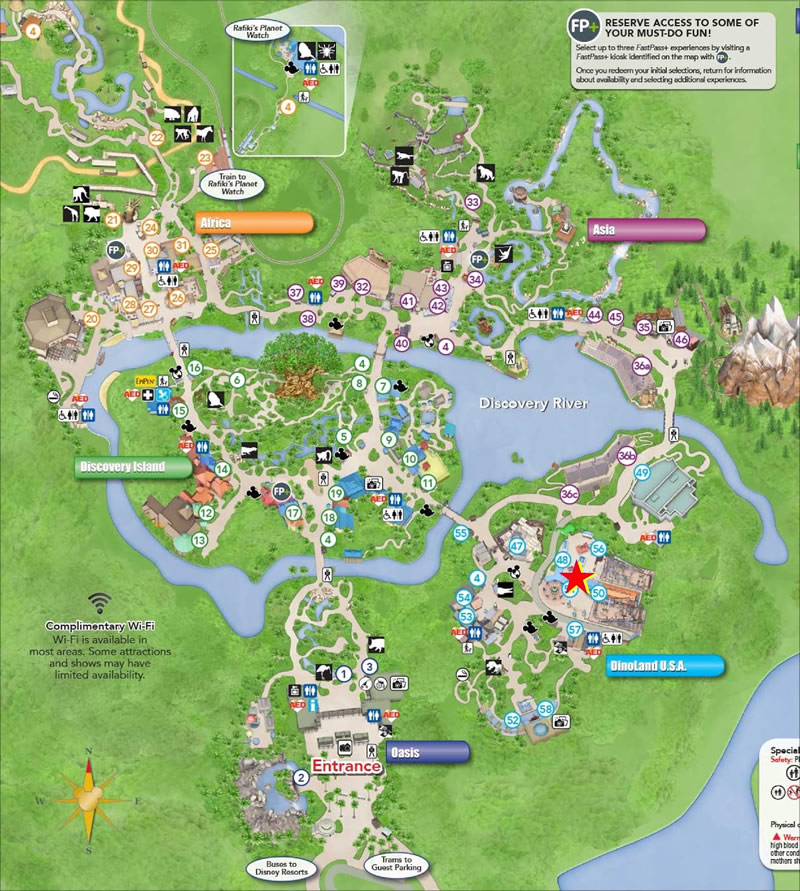
And one of the largest areas of DinoLand is Chester and Hester's Dino-Rama!
.jpg)
We are welcomed by several dinosaurs including front and center a Parasaurolophus with a long-tailed pterosaur above, possibly a Rhamphorhynchus.
Disney has described this area of the park as such:
The Story of Chester & Hester’s Dino-Rama! After rare dinosaur fossils were discovered in 1947, a group of scientists decided to buy the dig area. But one small property—owned by locals Chester and Hester—refused to sell and instead opened a dino-themed midway called Chester & Hester’s Dino-Rama!
So it is basically a dinosaur themed carnival attraction area. Not the most innovative Disney design, but whatever, it has dinosaurs.
.jpeg)
So let's head on inside.
They have two rides within the DinoRama!
.jpg)
The first is the Tricera-Top Spin. You won't catch me dead on it but there are several Triceratops in which you can ride, similar to the main entrance model.
.jpeg)
But somehow my daughter convinced me to go on the other ride, the Primeval Whirl. Here is the banner over the front of the ride. The ride has since closed back in March of 2020, luckily I got the pictures when I did.
.jpg)
There was a giant dinosaur in the vein of those dinosaur model kits where each bone is a piece of wood that locks together stuck into the middle of the ride. I think it is a T. rex but I am not certain.
.jpeg)
And...I'm on the ride.
.jpeg)
Here is the concept for the ride:
Back In Time
Take a trip aboard a spinning rollercoaster in this dinosaur-themed carnival-style attraction.
Hop inside a time-machine-styled contraption—created by research-scientist cousins Esther, Fester, Nester and Lester—and journey back to when dinosaurs ruled the earth. Climb a ramp and pass through a zany 4-ringed time portal before beginning a steady, swinging descent into the past.
A Trip to the Prehistoric Age
Sweep through a series of sudden dips and turns as your time machine spins on its own path. Whiz by cartoon-styled dinosaurs hastily preparing for their impending extinction and glimpse a shower of kooky meteors. Thrill to twists and turns and glide through a fossilized jigsaw puzzle of dinosaur bones before leaving the past behind and making your way back to the present.
So basically you go back in time and are trying to outrun the meteor at the end of the Reign of Dinosaurs.
.jpeg)
After finally getting off the ride, you are treated to a meteor pointing the way to where to throw up your lunch.
.jpg)
One of the main eye pieces of the area is this giant Apatosaurus. I took this picture of it back in 2016 (above) but apparently the dinosaur changed color since then (below).
.jpeg)
2017 had a new paint scheme.
.jpeg)
He's happy.
Like all good carnivals, they have an assortment of carnival style game spread throughout the area called Fossil Fun Games.
.jpeg)
Bronto-Score
.jpeg)
Whac-A-Packycephalosaur (sp)
.jpeg)
Get some treats at the "Corn-ivorse" (the puns were relentless).
.jpeg)
Not an actual game but it might have been back in the day. It is also one of the few artistic reconstructions of T. rex that actually appears to have two fingers.
.jpeg)
And of course I couldn't have left without getting a picture of this tribute to the past The Dino Diner. This appears to be a reconstruction of the original Iguanodon reconstruction from the Crystal Palace.

Crystal Palace Iguanodon courtesy of Darren Naish of Scientific American.
And to add to the history, the original reconstruction of Iguanodon actually predates these Crystal Palace reconstructions where a dinner was held inside the dinosaur reconstruction on December 31st, 1853. So, it is fitting that the homage is a diner.
Invitation sketch created by Benjamin Waterhouse Hawkins for the December 31st dinner. Printed in the January 7th, 1854 edition of the Illustrated London News.
The Boneyard was probably the best "paleontological" area of all of DinoLand U.S.A. and has several features within it. The first thing you notice as you enter DinoLand U.S.A. is a giant Brachiosaurus skeleton that you walk under.
.jpeg)
.jpeg)
The story behind this area is that the Boneyard is "run" by an organization called The Dino Institute. The Institute is a made up organization (at least I'm pretty sure it is) designed to make the experience appear that much more real. Within the Boneyard there are several slides, mazes, stairs, and bridges around fake rock walls will "fossils" built into them.
.jpeg)
A welcoming sign.
.jpeg)
The Dino Institute's logo
.jpeg)
A view of a potential dinosaur excavation site.
.jpeg)
A large bone within that excavation site.
.jpeg)
A Parasaurolophus skeleton built into one of the walls.
.jpeg)
Random mammoth skull within a field of dinosaur bones. Seemingly out of place but we will come back to the mammoth. It does have a purpose here.
.jpeg)
T. rex skeleton towards the back of the complex.
.jpeg)
Many of the dinosaurs also come with informational signs so that the kids can learn some more about them if they are interested.
.jpeg)
Pachycephalosaurus
Towards one side of the area there is a walkway that brings you across a bridge to another area that is an active "dig" and theoretically a different rock layer since this area isn't dinosaur specific. To get there you must now walk essentially within the Brachiosaurus.
.jpeg)
.jpeg)
.jpeg)
Looking up into the Brachiosaurus skeleton as I walk by.
.jpeg)
As you leave the walkway, you can look down into this separate area made up of an entire dig site. And what are they digging here?
.jpeg)
Why it's a mammoth! Told you we would come back to that.
.jpeg)
Complete with a descriptive board to give the kids the information that they need.
.jpeg)
Back across the bridge we head to go to the play area. As you walk around the back it appears they have a whiteboard set up with with a list of the fossils they are working on.
.jpeg)
However, looking at the names of the species and other info, I'm questioning the veracity of this information.
.jpeg)
Random T. rex statue next to the whiteboard.
.jpeg)
And a little more information about the science of paleontology in general.
It has actually been a very long time since I have ridden the DINOSAUR ride, or even been inside the building, so these pictures are primarily from the area surrounding the ride. There is one very notable inclusion from this area which I will go into below.
.jpg)
Here is the main entrance to the DINOSAUR ride with Aladar the Iguanodon from the movie Dinosaur (2000).
Here is the text from the ride website:
A Joyride to the Dinosaur Age Travel back in time on a perilous race to rescue an Iguanodon before the meteor that wiped out the dinosaurs strikes. Step inside the pristine halls of The Dino Institute, a one-time secret research facility and museum that is home to real fossils dating back to when dinosaurs walked the earth. Stroll past prehistoric exhibits and behold the colossal skeleton of the carnivorous Carnotaurus, one of history’s most feared dinosaurs.
A Secret Mission Make your way into the research control center and watch an informative video about your expedition into the primeval past. The briefing takes a turn when you’re recruited to rescue an Iguanodon from extinction and return to the present with the 3.5-ton dinosaur in tow. There’s just one problem: the date you’ll be visiting is when a giant meteor hit earth and caused the extinction of nearly all living things.
Blast to the Past! Board a sturdy, 12-seat Time Rover and race through a darkened forest in search of the tagged dinosaur. Speed past a spiky Styracosaurus grappling with a nearby tree. Brace yourself as you careen through unpredictable hairpin turns, a ragged Alioramus foraging for food nearby. Dart around a fearsome Velociraptor hunting for prey and avoid the clutches of a Cearadactylus soaring overhead. As the countdown clock ticks, meteors crash all around you: The end is near. Suddenly, the terrifying roar of an unimaginably huge beast can be heard in the distance. Is it the friendly Iguanodon you’re searching for—or the dreaded Carnotaurus looking for a meal? Time is nearly up. Will you complete your mission and make your escape? Or will you join the dinosaurs and become extinct?
Location of the DINOSAUR ride.
.jpeg)
Here is Aladar at night.
.jpeg)
Some posters around the ride building promoting the dinosaurs that you'll find on the ride. Here is Alioramus,
.jpeg)
.jpeg)
and Styracosaurus.
But here is the big thing that I wanted to see... SUE!!!!!
.jpg)
If you don't recall, back in 1997 Sue, the T. rex, was sold at auction for one of the highest prices ever paid for a fossil. The purchasing entities were a combination of the McDonald's Corporation, The Chicago Field Museum, and Disney. In return for purchasing the skeleton, Disney acquired a cast of the skeleton, which you see here. The actual skeleton is mounted at the Chicago Field Museum for everyone to see.
.jpeg)
.jpeg)
Actual skeleton of Sue with a reconstructed skull at the Chicago Field Museum.
.jpeg)
The real, crushed, skull of Sue on display nearby the skeleton at the Chicago Field Museum.
.jpeg)
Sue in a grainy nighttime photo.
.jpeg)
Slightly better nighttime photo of Sue.
.jpeg)
Sue's informational plaque.
And for the last part of Animal Kingdom, we are going to look at many of the miscellaneous dinosaurs around DinoLand U.S.A.:
.jpeg)
The entrance sign to DinoLand U.S.A. which features the Brachiosaurus from The Boneyard.
.jpeg)
Right next door to Chester and Hester's Dino-Rama! is Chester and Hester's Dinosaur Treasures store. Here we are looking at the front of the store and neighboring Dino-Rama!.
.jpeg)
On the way to the store we have this random billboard, which is likely being used as a photopass backdrop.
.jpg)
And then there is this thing that has always fascinated me. This "thing" is also reminiscent of the Crystal Palace Iguanodon (like the Dino Diner in Chester and Hester's Dino-Rama!) but far more gaudy than anything has a right to be.
.jpeg)
Front entrance to the store with the appropriate billboards for the authentic time period.
.jpeg)
Another billboard over the store advertising our imminent doom by asteroid.
.jpeg)
Within the store we have a plethora of dinosaurs littered about.
.jpeg)
With tons hung up from the ceiling.
.jpeg)
And out the back door of the store there are a few random dinosaurs to play on. Unfortunately, it was getting dark by this time and I couldn't really take pictures of them but I did manage to grab a shot of the Corythosaurus here.
.jpg)
Another Dino Institute logo on an ice cream stand.
.jpeg)
My favorite sign of the entire park right here for "Trilo-bites".
.jpeg)
Here is a random dino skull and hands next to the "Gargantuasarus World Tours" sign, of which the name "Gargantuasarus" is completely made up. The skull itself here is also indecipherable, with hints of T. rex mixed up in it.
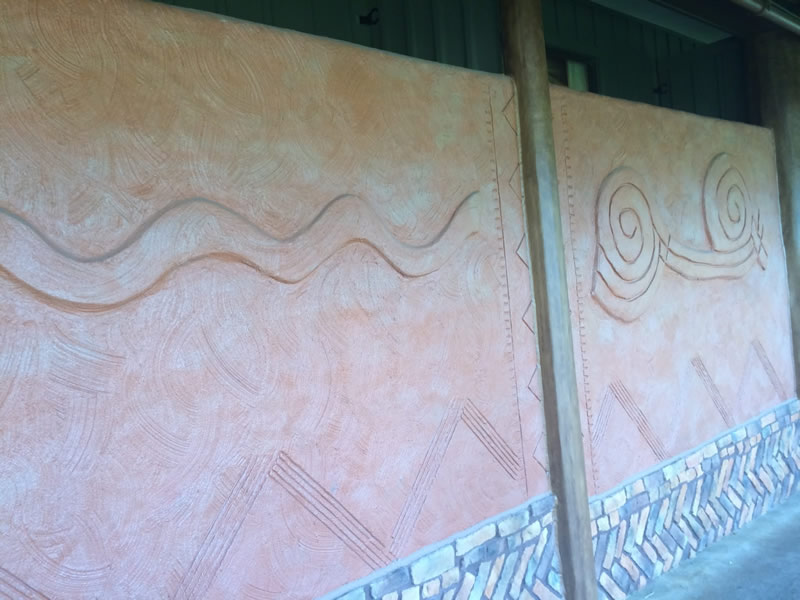
And to top it off, I found these images which are remarkable similar to trace fossils that I worked on for my PhD research termed "graphoglyptids".
Cosmorhaphe from the Palaeocene-Lower Eocene of Poland.
Spirorhaphe from the Late Cretaceous of Tanzania.
Within Hollywood Studios there are a couple instances of Dinosaurs of Disney.
Slinky Dog Dash - Rex the T. rex
The first Dino of Disney I will cover was introduced to us way back in 1995. That is of course Toy Story's Rex the T. rex.
.jpeg)
With the opening of Toy Story Land, specifically the Slinky Dog Dash, in 2018, we had the wealth of opportunities to highlight one of the most prominent dinosaurs in the Disney lexicon outside of Aladar from the DINOSAUR movie. We visited Hollywood Studios during early January of 2020 and Rex still had his holiday reindeer antlers on at the time.
.jpeg)
When you start off the Slinky Dog Dash, you pass by the box from which Rex came from. This box proves that despite the three fingers (of which T. rex only has two), that Rex is definitively considered a Tyrannosaurus rex, at least in Toy Story canon.
.jpeg)
The stats on the side of the box for Rex are:
- Tyrannosaurus means "Tyrant Lizard" in Ancient Greek, and Rex means "King" in Latin
- The most feared dinosaur of the Cretaceous Period
- One of the largest carnivorous dinosaurs with an enormous jaw and extremely small forearms
Also Available from Borealis:
Triceratops • Parasaurolophus
These stats are amazingly all correct (ignoring the hyperbolic comment about "most feared" and the capitalization of "Rex") and completely not out of place as the writing on the side of a toy box.
The box also indicates that there are other dinosaur toys from the made up Borealis company including a Triceratops, whom, although I didn't see any indication of her in the park itself, we have seen in the Toy Story movies by the name of Trixie.
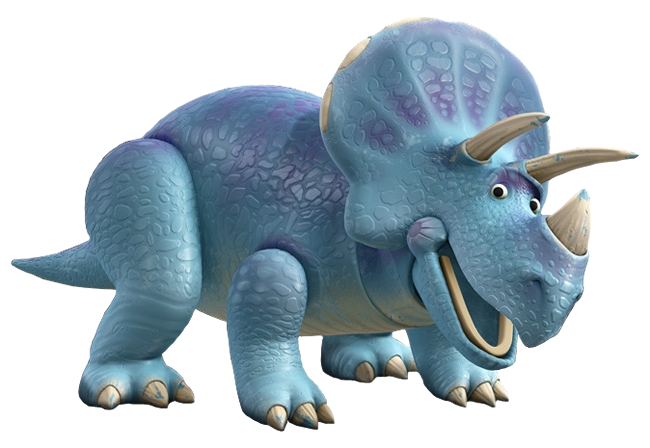
Looking up the origin of Rex. It turns out that he was modeled after the T. rex toy from the Dino-Riders cartoon series from back in the late 1980's.

Here is the T. rex from the first episode of Dino-Riders, which you can actually watch on YouTube.

And the toy that got made for the T. rex, (courtesy of @toysthatmadeus on Twitter)
Interestingly enough, as I mentioned Rex has 3 fingers (created in 1995), which are quite clearly seen on the side of the box. However, looking at the source dinosaur from 1988's Dino-Riders, both the cartoon and the toy T. rex have only the correct number of fingers, two.
There are a lot of features on a toy T. rex that can be fudged for play factor and still it would give the impression that it is a T. rex, even if it doesn't 100% look like one (hence the more archaic upright stance of the figure versus the Jurassic Park version of the T. rex with it's more laid out stance) but the number of fingers is a simple one people frequently make wrong that is an obvious mistake when made.
Dinosaur Gertie's Ice Cream of Extinction
Perhaps what is the most notable dinosaur in Hollywood Studios is the large Brontosaurus sitting in Echo Lake near the main open area after walking through the entrance shops. This dinosaur has been here since the park opened as MGM Studios back in 1989. The dinosaur houses a soft-serve ice cream shop called Dinosaur Gertie's Ice Cream of Extinction.
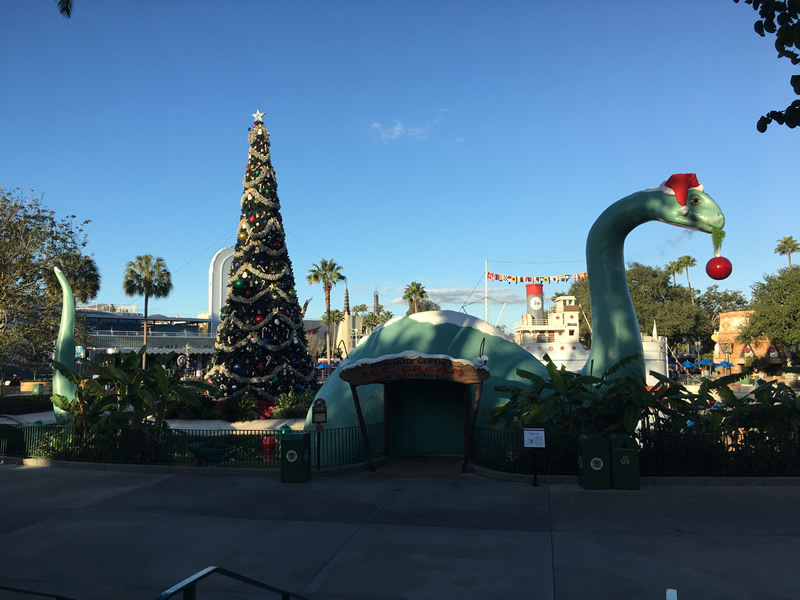
Here is a shot of the dinosaur during January's Marathon Weekend with the dinos Christmas decor still on. Despite seeing this dinosaur every time I entered the park though, it wasn't until an episode of Drawn: The Story of Animation by Holly Frey that I realized the origins of the dinosaur.
MGM Studios was essentially built as a working backlot studio as well as an homage to the movie industry with Grauman's Chinese Theater a central landmark within the park and The Great Movie Ride and the Studio Backlot Tour playing prominent opening ride roles. So, it is not surprising that the dinosaur in the lake has a theatrical history.
On top of that, the designs around the Echo Lake region of the park were set to mimic the "Hollywood Crazy" form of architecture from Hollywood's Golden Age including weird structures such as the roadside dinosaur attractions that can still be seen in various locations across the US. When it came up, the dinosaur they built was actually modeled off of one of the earliest forms of animation that ever premiered.

Created in 1914 by Winsor McCay, the cartoon is one of a dinosaur named Gertie. The dinosaur, a Brontosaurus, was created as a vaudeville act where McCay interacts with the dinosaur telling it what to do like a trained elephant. This animation of Gertie is one of the earliest forms of animation ever created and the earliest to feature a dinosaur. The cartoon is also one of the most influential animations ever having influenced the likes of people like Walt Disney, who started creating animation shortly after in the early 1920's.
Here is the full version of the Gertie cartoon on YouTube:
Apparently, this ice cream shop also lived up to its name of "Ice Cream of Extinction" where it served rare types of ice cream from around the world. However, now a days it is only a soft-serve shop.
Although not dinosaur related, there is another strong paleontological connection in Hollywood Studios and that involves the entire backdrop of the Star Wars Galaxy's Edge land within the park.
.jpeg)
The entire park of Galaxy's Edge takes place within the canon of Star Wars on a planet named Batuu. This settlement on Batuu is known as Black Spire Outpost, named after the spires located throughout the backdrop and within the park itself, specifically one spire in particular that is blacker than the other spires. Here is the blurb from starwars.com:
"Widely known for the petrified remains of its once towering ancient trees, the spires now stand guard across the river valleys and plains and have long captured the imagination of travelers to this planet."
.jpeg)
In canon, these spires are petrified trees that were petrified in place, where the tops of the trees were not preserved (either they eroded away over time or only the bottoms were petrified and the tops decayed before preservation). Petrification is a specific type of fossilization that refers to trees. This process involves the replacement of each living/biological molecule with mineral molecules.
.jpg)
The replacement process, or permineralization, occurs when minerals dissolved in water, frequently silica in the instance of petrification, flow through the water and do a (typically) 1-to-1 replacement of the molecules leaving behind a nearly perfect replica of the tree. These petrified trees no longer contain living (or dead) tissue but are essentially tree shaped rocks. For this process to occur though, the trees need to be buried, or at least submerged, in silica rich waters. It is also helpful if there is a lack of oxygen, because without oxygen the trees can't decay. For this to have occurred with all of these trees still standing upright, the entire region would need to have been buried or flooded with anoxic (lack of oxygen) waters or sediment (mud).
.jpeg)
The inspiration for these petrified trees came from a National Park within northeast Arizona, Petrified Forest National Park, where one can actually go see real life petrified trees. The difference here is that although the trees in Petrified Forest are huge, they are nowhere near as big as the ones in Black Spire Outpost, and also most, if not all, of the trees in Petrified Forest are preserved after they had fallen over.
.jpg)
Here are some of the lovely petrified trees from Petrified Forest National Park. I had done a post about the geology of Petrified Forest a little while ago and contains some more pictures and information after the fossilization process.
.jpg)
A close up of an actual petrified log from Petrified Forest National Park.
.jpeg)
Back to Black Spire Outpost.
.jpeg)
Here is a close up shot of one of the petrified stumps that really looks a lot like a petrified log. The artisans at the park spent a lot of time crafting each spire individually so that they not only looked like trees, but petrified trees, and each unique so they don't look cookie cutter.
.jpeg)
Here are some more spires off in the distance. These petrified tree spires also share a relative in Disney's California Adventure with the petrified Millennium Tree on the Redwood Creek Challenge Trail.
None at this time
Maleficent Dragon Parade Float
Here we look at what is not a direct dinosaur, but possibly the evolution of dinosaurs' influence on medieval cultures over time, and that is the dragon!
I had talked about it before but there is evidence that dinosaur bones possibly led people to create dragons over time. And as time continued these dragons have evolved within our culture just as animals evolve in nature until we are left with the remnants of that evolution. So, for that reason, I like to treat dragons as if they are the descendants of dinosaurs. And with that I present the dragon of Magic Kingdom: Maleficent.
.jpeg)
Premiering in 1959's Sleeping Beauty, Maleficent was the primary villain of the movie appearing in human form for most of the movie until the climax at the end where she transmogrifies into the dragon. This particular dragon was part of one of the many parades that had gone by when we were there in January of 2020.
.jpeg)
The parade float is from the Festival of Fantasy parade and the dragon itself was actually mobile and spit fire out of its mouth.

Maleficent in her dragon form from the original Sleeping Beauty.

